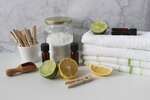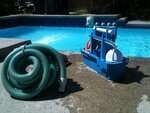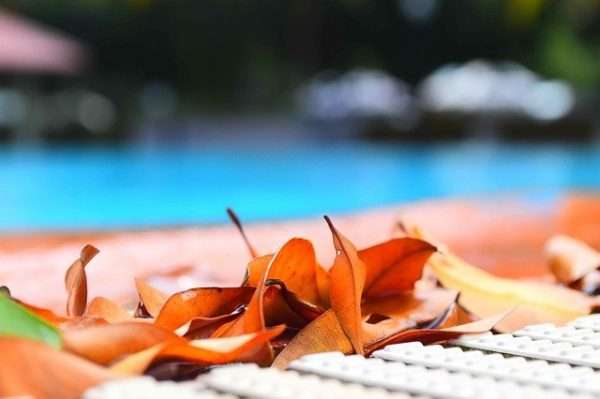Cleaning and maintaining a pool require a lot of workforces. But that doesn’t even compare to the expense of the cleaning products. There are a few useful hacks that will make cleaning pools cheaper and faster.
Do it yourself pool cleaning hacks are not substitutes for chemical treatments. In some cases, they will be lesser effective but will get the job done. And in others, they will work much better than chemical supplies.
These cleaning ideas deal with chlorinating your pool and maintaining a pH balance. Some help with scrubbing stains and keeping filters clean. You should also invest in a pool testing kit. You can find many digital ones as well as analog ones such as these test strips.
So, here are 12 of the most popular Do it yourself swimming pool cleaning hacks without any further ado.
12 Do it yourself Pool Cleaning Ideas:
1. Bleach:
What you’ll need:
- 5.25% bleach.
- Cyanuric acid (optional).
- Test strips.

Pool chlorine cleaners can be substituted with household bleach. Most household liquid bleach cleaners are dilute solutions of sodium hypochlorite (NaClO). They’re typically in a 5.25% concentration. You can add one gallon of bleach for every 10,000 gallons of pool water you have. Be sure to check the concentration of the bleach before buying it.
For the first time, you can use up to 2 gallons to sanitize the swimming area. Be sure to measure the right amount of bleach before adding it, as it’s quite a corrosive substance. Ideally, you want 3 ppm of chlorine in the water.
A single gallon of 5.25% bleach for every 10,000 gallons will raise the chlorine concentration by 5.25 ppm. You can use a ppm meter or test strips to check the concentration.
Commercial pool cleaners also use another ingredient, cyanuric acid (CYA). This acid prevents chlorine from burning up in the sun, which means it’ll stay in the water for longer.
You can buy the acid separately and add it to your do it yourself pool cleaning bleach solution. Or you can do all your cleaning chores at night.
You can also use bleach to scrub out stubborn stains on the walls of the pool. But remember only to buy the unscented variety as you don’t want any nasty bleach smells.
2. Baking Soda:
What you’ll need:
Recipe 1:
- ¼ cups baking soda.
- ¼ cups white vinegar.
- 1 tbsp. liquid dish soap.
- 2 gal water.
Recipe 2:
- Baking soda.
- Water.
Baking soda (not to be confused with baking powder) is a highly versatile product consisting of sodium bicarbonate. It’s the right bleaching agent and will take care of most scrubbing and cleaning chores.
You can use it on your pool’s tiles as well as the grout. And the best part is that it’s non-abrasive.
One common recipe involves white vinegar and liquid dish soap. Mix ¼ cups of baking soda, ¼ cups of vinegar, 1 tablespoon of liquid dish soap, and 2 gallons of water (warm). Use this to mop up the tiles around the pool.
You can either use the above recipe for tiles in the pool, rinse it afterward, or make a more straightforward solution. Mix water and baking soda in a suitable ratio such that they make a thick paste.
Then use a sponge or a clean cloth to scrub inside the pool. You can also use a toothbrush to scrub between the pool tiles. Remember to rinse it properly.
You can also use baking soda to increase your pool’s alkalinity. Add about 1.5 pounds of baking soda per 10,000 gallons of pool water. This will increase the alkalinity by 10 ppm.
Too confusing for you? Here’s a video that summarizes it:
3. Muriatic Acid:
What you’ll need:
- Muriatic acid.
- Eye protection glasses.
- Acid-resistant boots.
- Acid-resistant gloves.
- Acid brush.
- Test strips.
Muriatic acid is a useful pool cleaningsubstance meant for acid washing your pool. You’ll want to do this about every 5 years if your pool is in-ground and made from gunite or concrete. Do nottry to acid wash a vinyl-lined pool or an above-ground pool.
First, drain the entire pool and replace the hydrostatic pressure relief valves. Then dilute the acid by adding the acid first into the water in an almost 1:1 ratio. Try keeping the acid concentration a little less than the water.
Caution: Never add water to acid. Always add acid to water.
Then, use a hose first to wet down the surface. Then apply your acid mixture. Pour it circularly, and then scrub the surface with an acid brush. Leave the mixture on for up to a minute, then rinse it off well.
Add some soda ash to the rinsed-off water that will collect in our pool to neutralize it. Don’t let the acid enter your plumbing.
It’s best to first test the wastewater for its acidity before starting the drain. You may need to rinse the deep end more than one time.
Caution: Muriatic acid is highly corrosive, which is why you should wear eye protection, special gloves, and acid-resistant boots.
You can also use muriatic acid to lower the pH. This stands in contrast to baking soda, which increases the pH. Get a 10-gallon bucket and fill it up with water. Then add a cup of muriatic acid and stir gently until the water and acid are mixed.
Do not add the water into the acid, as this may cause boiling and overheating. Always add the acid to the water.
Now you can pour this solution into your pool. This will lower the alkalinity by up to 10 ppm in a 10,000-gallon pool. Add more of this solution if your pool is large.
4. Olive Oil:
What you’ll need:
- Olive oil.
- Sponge.
- Mild soap.
- Warm water.

It may seem like an odd entry for a Do it yourself pool cleaning hack, as oil and water aren’t the best of friends. And that’s true for the most part. But you can make use of olive oil to wash out your pool deck.
Olive oil is a good stain remover. It will help soften up tough stains such as gum, sap, or anything else that’s sticky and won’t budge.
All you need to do is apply the oil to the stain. Then clean it off with a sponge, some mild soap, and water. Be sure to clean it up as oil can be slippery, which may cause injuries.
Olive oil can be used to remove sticky bits from pool covers, plastic toys, pool floats, tiles, grout, and anything. You can even use it inside your pool. Just be sure to drain the pool and rinse the oil out once you’re done.
5. Borax:
What you’ll need:
- Household Borax.
- Test strips (optional).
Borax has been known throughout history as a natural household cleaner. Nowadays, it’s used mostly in laundry to remove stains and nasty odors. All you need to do is make a paste from it by introducing some water.
Then apply that paste to any sticky, slippery, or smelly spots inside or around your pool. It works best on tiles but can be used on vinyl as well.
You can also use Borax as a natural pH increaser. And you don’t even need that much of it. Add half a cup to 10,000 gallons of pool water, and you’re good to go.
It’s best to gradually add the Borax and check the water’s pH using the test strips after every addition. You don’t want the pH increasing too much.
6. Rubbing Alcohol:
What you’ll need:
- 50% to 70% rubbing alcohol.
- Or you can dilute your rubbing alcohol.
As a last resort, you can use rubbing alcohol, which most of us have in our households. If not, it’s readily available from the market. Rubbing alcohol typically refers to isopropyl alcohol, a common household disinfectant. It kills most pathogens and can be found in hand sanitizers as well.
Use rubbing alcohol to disinfect pool surfaces as well as for removing sticky substances such as gum. You can also apply some rubbing alcohol on a foam pad and rub it on stainless steel surfaces to make them shine.
All you need to do is dilute your rubbing alcohol with water such that it is 50% to 70% alcohol. Remember that the alcohol you use will already be diluted. To avoid miscalculations, you can buy rubbing alcohol in a 50% to 70% concentration and directly apply it.
Rubbing alcohol may also come in handy when you’ve got kids around the pool. It’s a natural disinfectant. So, if a kid gets injured, you can use it as an antiseptic. It is recommended to do so both for the child’s sake and prevent the bacteria from getting into the pool water.
7. Ascorbic Acid and Citric Acid:
What you’ll need:
- Citrus fruits or Vitamin C tablets.

Ascorbic acid, also known as Vitamin C, is a highly effective cleaning solution for removing stains and metal rust. It’s a natural cleaning agent that won’t be abrasive and will maintain the metal’s quality and shine. Citric acid is also highly reactive and will clean off most stains from metal.
There are many natural sources of ascorbic and citric acid. Both can be found in citrus fruits such as oranges, lemons, limes, and grapefruits. You can start by rubbing a halved piece of citrus fruit on the metal stains/rust. Use a clean cloth or a sponge to remove the citric acid and rinse.
Most people also keep Vitamin C supplement tablets at home. If you have those, you can start by stuffing a handful of them into a sock. Then rub that part of the sock on the affected metal areas and buff the stains.
You can also use powdered Vitamin C, raw ascorbic acid, citric acid, or crush the vitamin tablets into a loose powder.
8. Scale-Removing Solution:
What you’ll need:
- Vinegar.
- Test strips.
- Chemical calcium hardness reducer (optional).

If you’ve started coming across white chalky stains all over the inner pool wall, then it’s most probably scaling. Scaling refers to hard white calcium carbonate deposits that can sometimes come from a chalky substance.
It usually occurs when your water is highly contaminated with calcium or its compounds.
Here’s how you can make a do it yourself pool cleaning descaling solution. Mix water and vinegar in a 1:1 ratio. Then soak up your sponge in this solution and start scrubbing away at the scale formation.
If the stain is too strong, you can always try some lime juice and a pinch of salt. This will help soften tougher stains. You comma also use a brush or a toothbrush to scrub off the stains.
This technique is right up there with the baking soda and borax techniques. It helps loosen up the scale, and the vinegar solution must be washed off thoroughly.
In the future, to prevent calcium scaling, you can take some precautionary measures. Try to keep the water pH-balanced. The ideal pH of the water should be between 7.4 and 7.6. Use pH test strips to get an accurate measurement.
If your water has a higher total hardness content, you can try diluting it with softer water. You can find this soft water either from your home or from store-bought filtered water. Drain about a quarter of your pool water and fill it with filtered water. Test the water to make sure it’s free from calcium compounds.
You can also use a chemical calcium hardness reducer. But be warned, as these chemicals tend to promote algae growth in the pool.
9. Do it yourself Skimmer Sock:
What you’ll need:
- Pantyhose.
Your pool’s skimmer basket gets filled up quite often. And it can be a pain to clean it out. But even worse than a filled-up skimmer basket is a basket that allows some debris to fall through. Let’s face it; they’re not as effective. And that’s where this hack comes in.
If you can swap your skimmer basket out for a much less permeable material, say a pantyhose, then your filter will remain cleaner.
Stretch the pantyhose over the skimmer basket and tie it firmly at the rim. If you need to weigh the cloth down to fill the basket, simply use a rock or some other weights.
You can use any fabric type that does not let debris pass, but make sure it’s not waterproof and can stay stretched for longer. Pantyhose are the best for this job, but you can try other fabrics such as stockings, socks, and gloves.
You can also use a window screen or any type of mesh. But materials have tighter weaves and will prevent smaller debris from getting in.
Skimmer baskets act as primary filtration units. They remove larger debris that would otherwise clog the filter. While your filter can handle smaller debris, it does take a toll on it. Luckily, you can use this simple hack to filter off smaller particles before they reach your filter.
10. Do it yourself Pool Vacuum:
What you’ll need:
- 1″ PVC or plastic pipe.
- Plastic funnel.
- Pantyhose.
- Duct tape or rubber bands.
- Hot glue gun with glue sticks.

Don’t have a pool vacuum and don’t want to spend hundreds on some fancy brands? Then try this do it yourself pool cleaning hack. All you’ll need are a PVC hose, a household plastic or metal funnel, something to tie with (rubber bands or tape), and a pantyhose.
Make sure that the hose is about 1″ in diameter at the minimum. Start by lowering the hose into the pool so that it fills up with water. Then, take out your skimmer basket and secure the hose to the suction filter.
Next, secure a funnel at the free end of your hose. This can be done using hot glue. Neatly apply hot glue on both the outside and inside of the joint. Make sure there are no air pockets or paths for water to flow into.
Then, wrap the pantyhose over the mouth of the funnel such that it stretches tautly across the funnel’s open end. Use rubber bands or duct tape to secure the pantyhose in place.
You may also use any other fabric that prevents debris from going through but not water. You may use tight meshes or window screens.
And voila!
You have your very own do it yourself pool vacuum. Now all you need to do is submerge the end of the hose with the funnel into the water.
As your suction filter sucks in air, it will create a vacuum inside the hose. Then you can use the funnel-end of the hose to pick up dirt and debris.
The debris will get caught by the pantyhose, preventing a clogged filter. Keep a basket or bowl nearby to dump the debris into.
11. Pool Floor Cleaner:
What you’ll need:
- 1″ PVC or plastic hose.
- Pool brush or broom.
- Mesh or window screen (optional).
Cleaning out the pool floor can be a tedious task, especially if you don’t have a vacuum to lead the way. Lucky for you that there are a few different methods for cleaning the pool floor.
For this do it yourself pool cleaning hack, you’ll need a pool brush, a 1″-diameter PVC hose, and a pool pump or suction filter. The suction filter will already be present on your pool in the skimmer’s opening.
Firstly, use your pool brush to sweep any outstanding debris into the center. Avoid pushing any debris into the main drain. Then attach one end of your PVC hose to the opening of the skimmer basket.
This will act as your vacuum. Now all you need to do is extend the hose into the pool and suck up the debris you swept up.
If you don’t want to put too much pressure on your filter, you can also tie a cloth around the hose’s opening. This will act as a primary filter to filter out any larger particles. If you don’t have that, you can work with any mesh or screen.
Just make sure it’s not loose enough to let large particles through. Then you can simply sweep away the larger particles into a dustpan.
You could also use a cloth with a tighter weave, such as a pantyhose, to prevent smaller debris from going through. But then that wouldn’t be any different from just sweeping the debris away from the floor.
12. Sand Filter Improvement:
What you’ll need:
If you have a sand filter and want to improve it, you can add some DE powder. DE powder works by locking itself into the sand articles and prevents contaminants from passing through.
You can start by gradually adding 1-2 cups of DE powder to the skimmer basket. You’ll need to let the skimmer run one cycle to clean out the water properly.
Caution: DE powder can irritate the nasal passages and the eyes. It may also cause small abrasions on the skin and irritation. Avoid coming into direct contact with it.
FAQs:
Why do I need to maintain pH balance in my pool?
Imbalanced pH can lead to cloudiness in the water due to certain impurities. It may also abrade the skin, cause foul tastes, and have other side-effects. Moreover, acidic or basic pH can lead to abrasion of the pool tiles or vinyl. In addition to that, your equipment may also get affected.
What is the right pH level for pool water?
Pool water should ideally be between 7.4 and 7.6 pH. You might be thinking that since water is already of that pH, you don’t need to worry about it.
However, you’ll most likely use acidic or basic cleaning supplies that will interfere with the pH. This is why you will need to restore the pH and keep constant checks on it.
How often should I clean my pool filter?
There is no set time, as some days you get more debris than others. If the water is getting dirtier and your filter isn’t doing its job well, consider cleaning it. Similarly, if you’ve recently had algae bloom and fear that it could clog your filter, clean it out.
You can also check the filter pressure gauge. If the pressure is above 10 psi, it’s time to clean the filter. Otherwise, clean the filter after every six months or so.
Final Thoughts:
Investing in a swimming pool, whether for personal or commercial purposes, takes out a significant portion of your wallet. But the initial cost isn’t the only hurdle. Maintaining and cleaning a swimming pool can cost just as much.
Luckily, several do it yourself pool cleaning hacks make the job cheaper and more comfortable. These cleaning methods have been tried and tested. They can be used to balance the water’s pH, clean the tiles, grout, and steel, and aid infiltration. One of these hacks even lets you build your very own pool vacuum.
However, never substitute these for chemical supplies. Always invest in chemical supplies before you decide to try a do it yourself method.
Also, keep in mind that most of these methods are only for chlorine-based systems. For individual pools, it would be best to use supplies made for them.
So, try out these 12 cleaning methods and scrub your pool clean!




